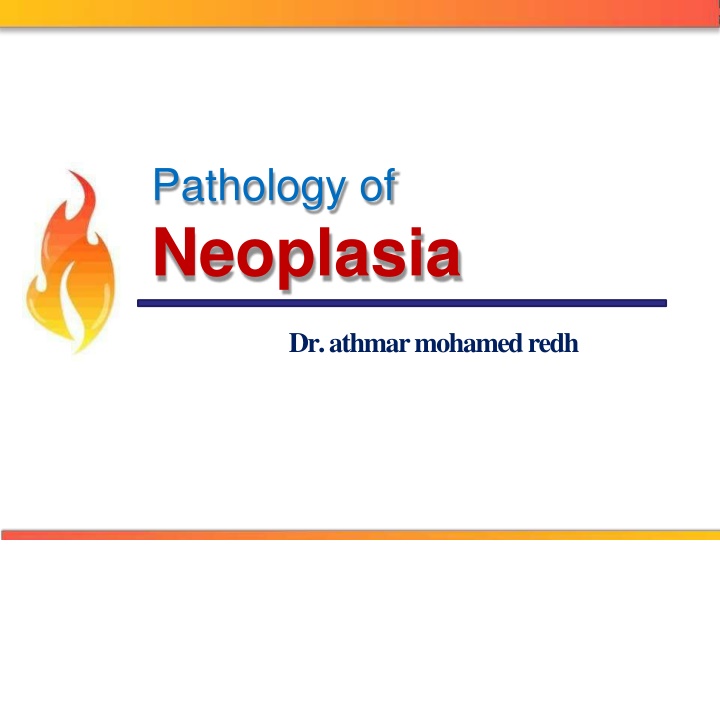
Neoplasia: Causes, Types, and Pathology Overview
Explore the world of neoplasia, covering its definition, types (benign and malignant), growth disorders, cell division control, clinical pathology, and nomenclature of neoplasms. Gain insights into the etiology, pathogenesis, morphology, and clinical features of neoplastic growths in this comprehensive guide.
Download Presentation

Please find below an Image/Link to download the presentation.
The content on the website is provided AS IS for your information and personal use only. It may not be sold, licensed, or shared on other websites without obtaining consent from the author. If you encounter any issues during the download, it is possible that the publisher has removed the file from their server.
You are allowed to download the files provided on this website for personal or commercial use, subject to the condition that they are used lawfully. All files are the property of their respective owners.
The content on the website is provided AS IS for your information and personal use only. It may not be sold, licensed, or shared on other websites without obtaining consent from the author.
E N D
Presentation Transcript
Pathology of Neoplasia Dr. athmarmohamedredh
Neoplasia Neoplasia: Neo + Plasia New + Growth. Tumour Swelling any swelling* definition: A neoplasm is an abnormal mass of tissue, the growth of which exceeds and is uncoordinated with that of the normal tissue and persists in the same manner after cessation of the stimuli which evoked the change Cell division without control *
Neoplasia Cell population / Growth Control: Proliferation Differentiation Apoptosis * Normal Neoplasia Benign - Malignant Stem cell Carcinogen Initiator + Promotor Inflam Organ / Tissue RAS Rb MYC p53 1.Proto-Oncogenes (growth factors) 2.Growth/Tumor suppressor genes. 3.Genes controlling Apoptosis. 4.Genes controlling DNA Repair. Apoptosis
Neoplasia Growth Disorders: Non neoplastic (Polyclonal) Neoplastic (Monoclonal) Hyperplasia Hypertrophy Aplasia Atrophy Metaplasia Dysplasia Normal Adaptation Benign Malignant
Neoplasia Cell division Control - Carcinogenesis*
Neoplasia Clinical Pathology Etiology (Carcinogenesis) Pathogenesis Morphology Clinical Features (Cancer Biology)
Neoplasia BENIGN MALIGNANT Malignant Poorly differentiated Rapid growth Non Cohesive, No capsule invasion/infiltration Metastases. - Benign Well differentiated Slow growth Cohesive, expansile Capsule No invasion/infiltration Necrosis 10
Neoplasia Neoplasms Nomenclature: Oma - Tumour Carcin-oma Hard Tumour Sarc-oma - Soft Tumour Benign Adenoma - Papilloma - Cell of Origin Malignant Adencarcinoma Squamous cell ca. Gland. Epithelium Lining. Epithelium Fibrosarcoma Osteosarcoma Chondrosarcoma Liposarcoma Leiomyosarcoma Fibroma - Osteoma - Chondroma Lipoma Leiomyoma Rhabdomyoma Rhabdomyosarcoma Fibroblast Osteoblast Chondrocyte Lipocyte Smooth muscle Skeletal muscle
Neoplasia Nomenclature: exceptions Teratoma Tumour of Germ cell multiple tissues. Benign (mature) or malignant (immature) Melanoma (Melano-carcinoma) Malignancy of melanocytes. Seminoma (Seminal carcinoma) carcinoma of Testes. Leukemia white blood Ca. of Haemopoietic stem cells. Lymphoma (Lymphosarcoma) Malignancy of lymphocytes. Mixed Tumours: Both epithelial & connective tissue components. Pleomorphic adenoma (Salivary gland) & Carcinosarcoma (breast/uterus) What is a Granuloma, Hamartoma & Choristoma?
Cancer Clinical Features Cancer Biology
Neoplasia Cancer Biology: Structure: Parenchyma Neoplastic cells. Stroma: Non neoplastic - normal DNA Features: Differentiation Maturation of cells. Rate of Growth Mitotic rate Local invasion Hemorrhage, necrosis, destruction Metastasis Distant Spread. 15
Tumors are clonal (one parent) But have different mutations different shapes & features. Each new mutation adds a new feature. Normal cell First mutation Second mutation Third mutation Malignant cells Fourth or later mutation More new mutations with time.
Neoplasia 6 Features of Cancer cells: Clinically each patient s cancer has a different mix of features depending on quality & quantity of mutations & changes with time...!
Neoplasia Pathogenesis of Lung Cancer. Irritation Carcinogens Initiation Promotion Ca. Anaplasia Smoke K-Ras C-myc p53 19
Neoplasia Colon: Normal Adenoma Carcinoma Carcinogenesis) Colon Cancer: Common type - 80%
Neoplasia Stage & Grade of Cancer: Staging: Progression or spread in the body. Grading: Cell differentiation & Rate of growth Microscopy. Well differentiated (low grade) Adenocarcinoma Grade Undiff. (high grade)
Neoplasia Prostate Ca : Gleason Grading: Low Grade High Grade 22
Neoplasia Metastasis: Lymphatic, Hematogenous, Direct.
Metastasis: Pathogenesis: 1. Cell loosening 2. BM degradation 3. Invasion 4. Locomotion 5. BV adhesion 6. Intra-vasation 7. Tumour embolus 8. Adhesion 9. Extra-vasation 10. Angiogenesis 11. Growth. E-Cadherin, -catenin Matrix Metalloproteinases (MMP) Collagenase (not in benign) Actin Cytoskeleton, chemokine What chemical mediators are involved? 28











